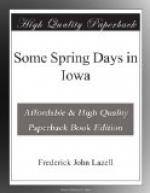* * * * *
We rise at length and walk along the wooded slope admiring new beauties at every step. Here is a thicket of wild gooseberry filled with dark green leaves and the tinkling notes of tree sparrows, and we hardly know which is the more beautiful. A little farther and we are in a tangle of pink and magenta raspberry vines from which the green leaves are just pushing out. The elder has made a great start; the yellowish-green shoots from the stems and from the roots are already more than six inches long. The panicled dogwood and the red-osier dogwood (no, not the flowering dogwood) as yet show no signs of foliage, but the fine white lines in the bark of the bladdernut, which have been so attractive all winter, are now enhanced by the soft myrtle green of the tender young leaves. The shrubby red cedar is twice as fresh and green as it was a month ago, as it hangs down the face of the splintered rock where the farmer boys have set a trap to catch the mother mink. But Mrs. Mink is wary. Here is a pile of feathers, evidently from a wild duck, which seems to indicate that while the duck was making a meal of a fish which she had brought to shore, the mink pounced upon her and ate both duck and fish.
While we stand looking there is a slight movement among the roots of a silver maple at the river’s brink. A moment later Mrs. Mink comes around the tree and towards us. She is about eighteen inches long, with a bushy tail about another eight inches, her blackish-brown body about as big round as a big man’s wrist, and she has a “business-looking” face and jaw. Did you ever try to take the young minks from their nest in the latter part of April and did Mrs. Mink fight? She hasn’t seen or smelled us yet, but suddenly when she is within seven feet of us, there is an upward movement of that supple, snakelike neck, a quick glance of those black diamond eyes, and she turns at right angles and dives into the river. A frog could not enter the water so silently.




